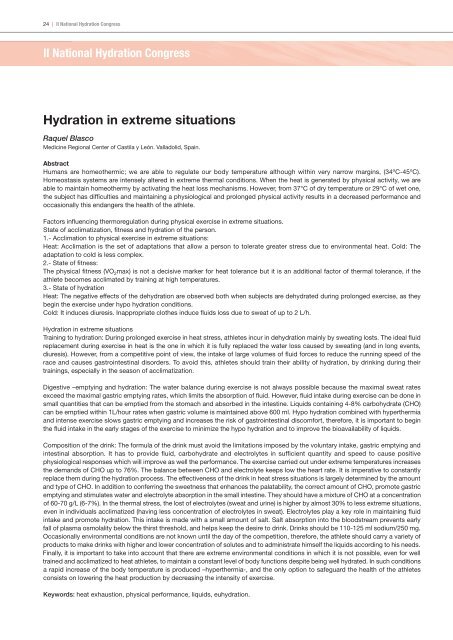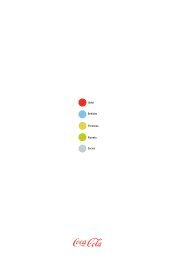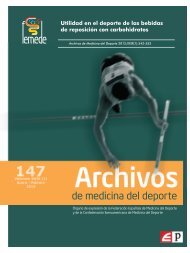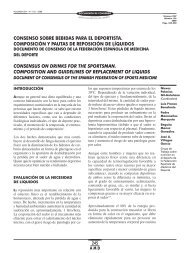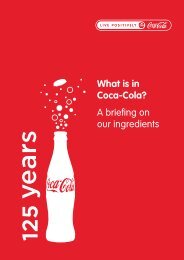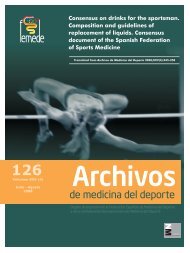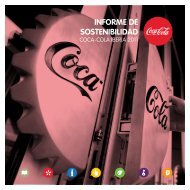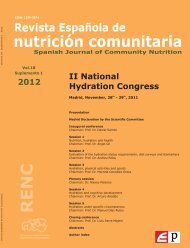II National Hydration Congress - Coca-Cola
II National Hydration Congress - Coca-Cola
II National Hydration Congress - Coca-Cola
Create successful ePaper yourself
Turn your PDF publications into a flip-book with our unique Google optimized e-Paper software.
24 | <strong>II</strong> <strong>National</strong> <strong>Hydration</strong> <strong>Congress</strong><strong>II</strong> <strong>National</strong> <strong>Hydration</strong> <strong>Congress</strong><strong>Hydration</strong> in extreme situationsRaquel BlascoMedicine Regional Center of Castila y León. Valladolid, Spain.AbstractHumans are homeothermic; we are able to regulate our body temperature although within very narrow margins, (34ºC-45ºC).Homeostasis systems are intensely altered in extreme thermal conditions. When the heat is generated by physical activity, we areable to maintain homeothermy by activating the heat loss mechanisms. However, from 37°C of dry temperature or 29°C of wet one,the subject has difficulties and maintaining a physiological and prolonged physical activity results in a decreased performance andoccasionally this endangers the health of the athlete.Factors influencing thermoregulation during physical exercise in extreme situations.State of acclimatization, fitness and hydration of the person.1.- Acclimation to physical exercise in extreme situations:Heat: Acclimation is the set of adaptations that allow a person to tolerate greater stress due to environmental heat. Cold: Theadaptation to cold is less complex.2.- State of fitness:The physical fitness (VO 2 max) is not a decisive marker for heat tolerance but it is an additional factor of thermal tolerance, if theathlete becomes acclimated by training at high temperatures.3.- State of hydrationHeat: The negative effects of the dehydration are observed both when subjects are dehydrated during prolonged exercise, as theybegin the exercise under hypo hydration conditions.Cold: It induces diuresis. Inappropriate clothes induce fluids loss due to sweat of up to 2 L/h.<strong>Hydration</strong> in extreme situationsTraining to hydration: During prolonged exercise in heat stress, athletes incur in dehydration mainly by sweating losts. The ideal fluidreplacement during exercise in heat is the one in which it is fully replaced the water loss caused by sweating (and in long events,diuresis). However, from a competitive point of view, the intake of large volumes of fluid forces to reduce the running speed of therace and causes gastrointestinal disorders. To avoid this, athletes should train their ability of hydration, by drinking during theirtrainings, especially in the season of acclimatization.Digestive –emptying and hydration: The water balance during exercise is not always possible because the maximal sweat ratesexceed the maximal gastric emptying rates, which limits the absorption of fluid. However, fluid intake during exercise can be done insmall quantities that can be emptied from the stomach and absorbed in the intestine. Liquids containing 4-8% carbohydrate (CHO)can be emptied within 1L/hour rates when gastric volume is maintained above 600 ml. Hypo hydration combined with hyperthermiaand intense exercise slows gastric emptying and increases the risk of gastrointestinal discomfort, therefore, it is important to beginthe fluid intake in the early stages of the exercise to minimize the hypo hydration and to improve the bioavailability of liquids.Composition of the drink: The formula of the drink must avoid the limitations imposed by the voluntary intake, gastric emptying andintestinal absorption. It has to provide fluid, carbohydrate and electrolytes in sufficient quantity and speed to cause positivephysiological responses which will improve as well the performance. The exercise carried out under extreme temperatures increasesthe demands of CHO up to 76%. The balance between CHO and electrolyte keeps low the heart rate. It is imperative to constantlyreplace them during the hydration process. The effectiveness of the drink in heat stress situations is largely determined by the amountand type of CHO. In addition to conferring the sweetness that enhances the palatability, the correct amount of CHO, promote gastricemptying and stimulates water and electrolyte absorption in the small intestine. They should have a mixture of CHO at a concentrationof 60-70 g/L (6-7%). In the thermal stress, the lost of electrolytes (sweat and urine) is higher by almost 30% to less extreme situations,even in individuals acclimatized (having less concentration of electrolytes in sweat). Electrolytes play a key role in maintaining fluidintake and promote hydration. This intake is made with a small amount of salt. Salt absorption into the bloodstream prevents earlyfall of plasma osmolality below the thirst threshold, and helps keep the desire to drink. Drinks should be 110-125 ml sodium/250 mg.Occasionally environmental conditions are not known until the day of the competition, therefore, the athlete should carry a variety ofproducts to make drinks with higher and lower concentration of solutes and to administrate himself the liquids according to his needs.Finally, it is important to take into account that there are extreme environmental conditions in which it is not possible, even for welltrained and acclimatized to heat athletes, to maintain a constant level of body functions despite being well hydrated. In such conditionsa rapid increase of the body temperature is produced –hyperthermia-, and the only option to safeguard the health of the athletesconsists on lowering the heat production by decreasing the intensity of exercise.Keywords: heat exhaustion, physical performance, liquids, euhydration.


